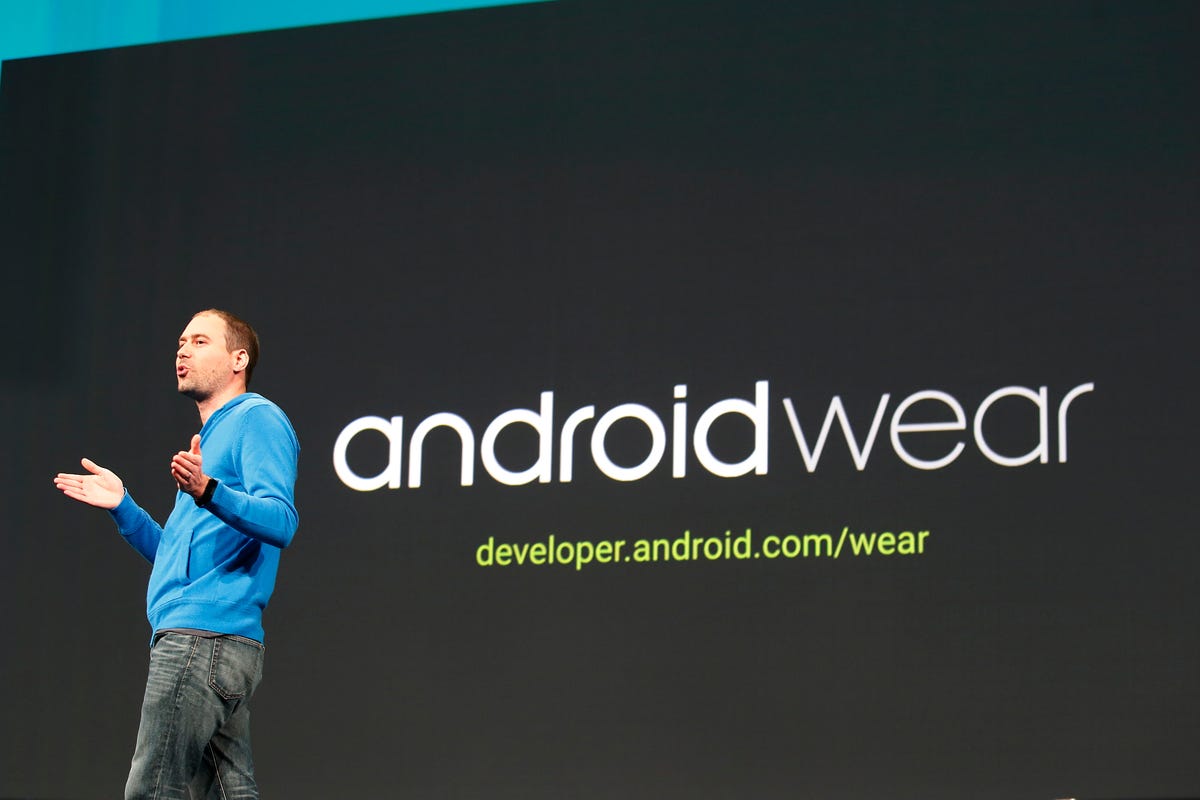
Stephen Lam/Getty Images
MOUNTAIN VIEW, Calif. — In the market for wearable devices, Google is dressed and ready to go.
Android Wear, which debuted in March as a modified form of Google’s smartphone and tablet operating system that’s been tailored for wearables, is already used on three smartwatches: the Samsung Gear Live, the LG G Watch, and the Moto 360, set to launch later this week.
Google, with “thousands” of Android Wear apps, knows that’s not enough. Archrival Apple will reportedly show off a wearable device of its own next week at a media event where it’s also expected to announce the next version of the iPhone. And at the IFA technology conference in Berlin this week, a handful of companies, including Sony and Samsung, are expected to talk about wearables.
At stake is dominance in the nascent but promising market in wearable devices. In 2013, 9.7 million wearables were shipped, according to CCS Insight, a research firm. By the end of 2014, that figure is projected to jump to 22 million. And by 2018, 250 million wearables will be in use, the research firm estimates.
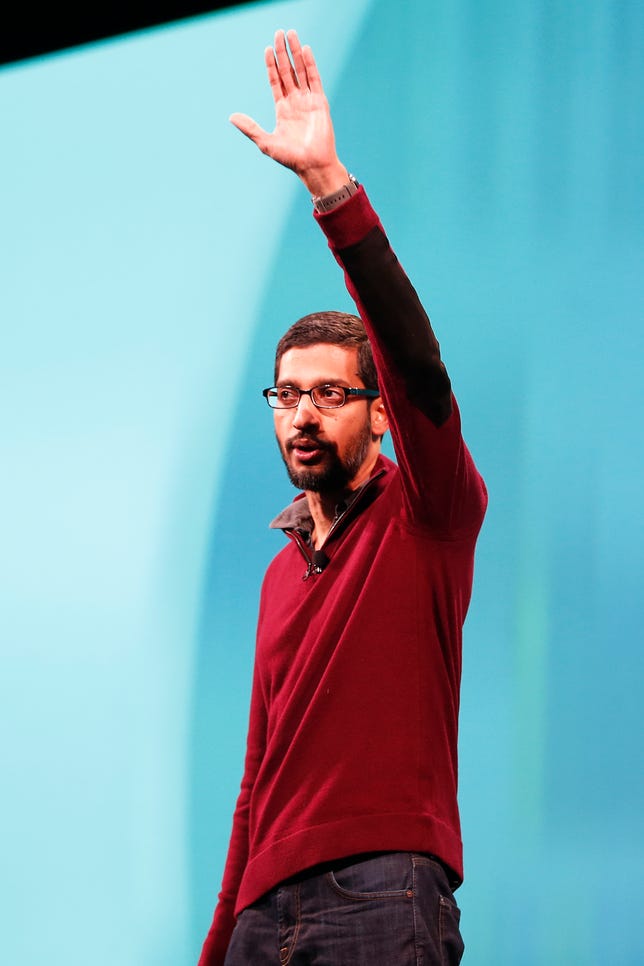

Stephen Lam, Getty Images
For big tech companies, the appeal is having another route to extend their reach to consumers — by being able to offer them services with different spins , and by having new methods for gleaning information about users in ways that smartphones and tablets cannot.
CNET met with Director of Engineering for Android Wear David Singleton and Vice President of Engineering for Android Hiroshi Lockheimer to talk about Google’s plans for wearables, why their approach to these smart devices is different from their rivals, and what they think of the future of sensor technology.
Those plans include updates to Wear that will be distributed through the Android Wear app on your phone.
“One of the things we’re going to be able to do is add the ability for these devices to start working with some of the other devices you might wear on your body,” Singleton said. “We’ll have an update coming that allows you to pair a Bluetooth headset with your watch. And that means you can play music stored on your watch directly on your Bluetooth headset.”
Below is an edited transcript of the conversation.
Q: Before we jump into Android Wear, I want to talk about Google’s outlook for Android. At I/O, Android Chief Sundar Pichai certainly laid out an ambitious plan.
David Singleton: This year we have a huge focus on being able to meet the user wherever they are, across devices with Android. Obviously, we’ve got great momentum with phones and tablets, and we’ve got a great developer ecosystem. There are so many services that work so well with Android phones and tablets. So it’s exciting to bring the insights that we’ve got there and that platform to more form factors.
Hiroshi Lockheimer: I think the idea is, you look around and there are all these screens everywhere. These screens don’t know how to talk to each other. They are islands. So how do we unify them and have a common platform where apps and services and information can flow between these screens and give more utility to your life.
Related Stories
- Google’s Android Wear team: We’ll update early and often
- Google spells out ambitious plan: Android world domination
- Time for Android Wear: Google shows off Samsung, LG, Motorola smartwatches
- With Gear S watch, Samsung tinkers — and tempts fate
- Apple wearable rumored to debut with iPhone 6 in September
Google has Glass, and now Android Wear. What’s the company’s overall approach to wearables?
Lockheimer: Our approach to wearables is the same as our approach to any of our products: We want to build technology that delights people by improving their lives. So our approach to wearables — watches, Glass, even our smart contact lens project which is designed to help people with diabetes measure their glucose — is to build things that you use when you need and forget about when you don’t. We want wearables to help you stay in the moment, instead of taking you out of it: giving you a safer way to get directions, easily share or record what you see, communicate with others quickly, or get the information you need when you need it.
What will we see in new updates?
Singleton: One of the things we’re going to be able to do is add the ability for these devices to start working with some of the other devices you might wear on your body. So we’ll have an update coming that allows you to pair a Bluetooth headset with your watch. And that means you can play music stored on your watch directly on your Bluetooth headset.
Alongside that, we’re introducing GPS support for the platform. So that’s obviously only for devices that have the GPS hardware. But we’re excited about those two features together because it unlocks a whole set of new use cases.
If you’re someone who likes to go for a run, it might be convenient to be able to leave your phone at home. So you can start recording your track with GPS on the watch. You can throw on some music and have a really enjoyable run. And when you come back home, everything will be synced up with the apps running on your phone.
Another update that I’m really excited about because I think it will be great for developers and end users — a release that will allow third parties to develop watch faces, and make them available for download at the Google Play store.
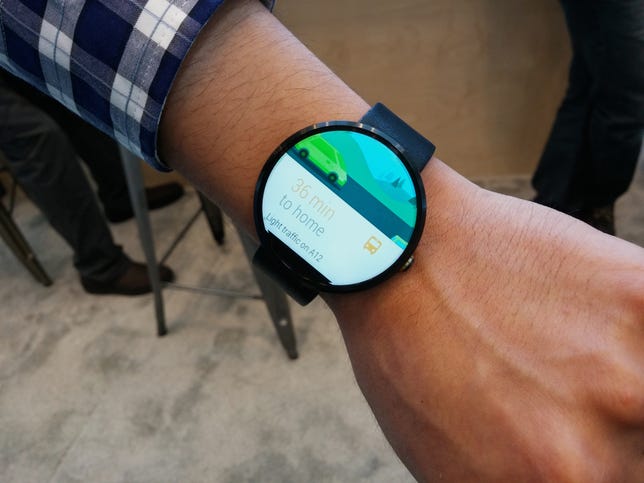

James Marin/CNET
It’s actually kind of interesting because we haven’t yet launched the API for that, but we’ve already seen tremendous innovation from some third parties who have been able to figure out how to do some of this on their own. And we’ve already seen excitement for building watch faces that allow you to express a bit of your own personal style, or really help you work in specific things you might be doing. For example, if you’re taking a hike, maybe it’s interesting to out the specific distance you’ve traveled right there on the watch face. If you’re someone who cares about a specific stock or specific score of a sports team, maybe you can have a sports team watch face and put their latest score right there on the watch face.
How soon are those updates coming?
Singleton: There will be several before the end of the year. You’ll see one come out [this] week where we’ll be able to improve the navigation experience and some of the voice action experience.
When Google updates Android on phones, the company first has to wait for wireless carriers to test the software before it can ship. With Wear, since carriers aren’t involved, you’ll be able to push updates without waiting. Can you talk about taking that different approach?
Singleton: We really don’t think about it particularly differently. We’ve been working with all of our partners to make sure we can keep bringing functionality through, whether it’s through device updates or through Google Play Services. We’re using exactly the same mechanisms here. It really is Android, and the Android model. Specifically for wearables, we realized as a category, we’re pretty early. So it’s really the intention to do those as frequently as we need.
One of the things competitors always bring up when they try to knock Android is to say it is fragmented. For wearables, does having a bit more control over updates serve to address that?
Lockheimer: I think the key point is that it is a new product category. And the needs are different. Phones and tablets are much more mature, from a technology perspective. It’s much more understood how people use it. And people’s expectations are more firm. Whereas wearables, as David was saying, is a completely new category. We just want to be able to iterate very very quickly.
This happened also, by the way, on phones. I’ve been doing this since 2006 at Google. In the early days of Android, there were many more releases of Android, more often. We still innovate very rapidly on the phone side, but it’s not as rapid as in 2008, for instance, or 2009. I think you’re going to see the same trend here. We’re going to much more rapidly iterate here.
There’s fewer players involved too. [Wireless] operators aren’t really involved here. We’re working with a select number of [hardware partners]. In this case, since we do have this infrastructure, the manufacturers decided that, since you guys already did it, we’ll just keep using what you’ve made. That aspect of it is almost an implementation detail. I don’t think it’s a big policy thing or anything like that.
[Updating Android on phones and tablets] is a big pipeline of work. Many companies are involved. And many schedules need to line up and things like that. And it’s a lot simpler on watches. Not just on operators, but there are different things on that pipeline that just don’t exist. And it really simplifies the whole pipeline and makes it possible for us as an industry to push these updates out a lot quicker.
How many developers are using Android Wear?
Singleton: We have literally seen thousands of applications updated in the Play store to have Android Wear support.
I just was playing with an app at my desk, which is pretty awesome. It allows you to play guitar with your watch. [He demonstrates by strumming his hand in front of his Moto 360 smartwatch, set to launch later this week.] You have your phone on your desk, and it’s got a speaker. And you can strum your watch. And obviously, that’s a bit of a gimmick, but there are lots of apps out there.
And we’re actually beginning to see some of the services people use the most bringing in Android Wear support. So, for instance, Facebook Messenger has support for voice replies. The beta version of Whatsapp Messenger has similar functionality. So it’s really exciting to start to see really deep engagement with the platform.
Lockheimer: The guitar thing is interesting.
Singleton: We never would have thought of that.
How do you encourage hardware partners to experiment with sensors?
Singleton: Sensors are the key way we think there will be both innovation in this space, and some of these devices will be different from each other. One of the things we set out to do when we set out developing the platform was to make it possible for a manufacturer to bring any sensor they could find to the platform. And we’ve definitely seen real innovation there. It’s been exciting to see devices come out that have optical heart rate sensors, but we’re also seeing other technology in that space, and it will be really interesting to see some of those devices come to market.
Google I/O 2014: Android wearables coming to your wrist (pictures)
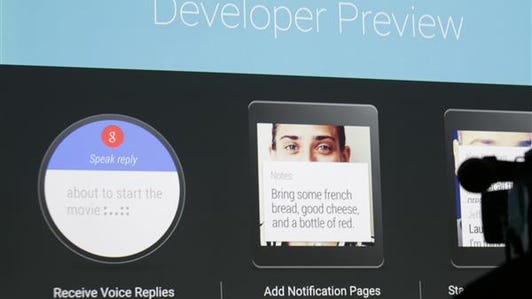

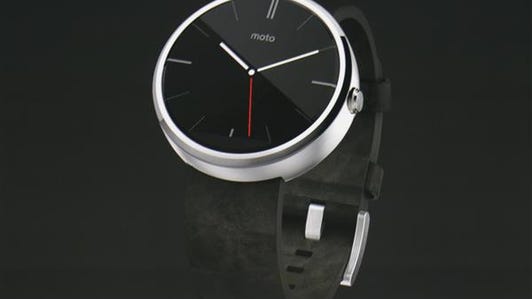

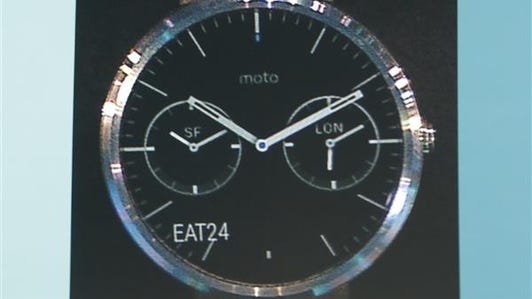

We’re also seeing people do interesting things with sensors like altitude and pressure. You can imagine a device that’s particularly aimed around taking a hike. Or skiing. It’s a great way to track how far you’ve skied or descended in a day. Those were not sensors that, at the outset of this project, we really thought were core and important. But no we see they are really unique use cases. It’s our absolute core goal to enable any sensor technology to work with the platform.
Lockheimer: Also, we announced this thing called Google Fit [a platform for developers to consolidate fitness metrics, with users’ permission]. So we’ll have this service that really integrates all these sensors and give you a holistic view of what’s happening to your body, or yours surrounding, or whatever it is.
What flexibility will manufacturers have to modify the Wear software?
Singleton: When we designed the software, we tried to figure out, what were the ways that it was going to be important for manufacturers to add their own flavor to their device. So it’s pretty flexible. Like I said, they can add any sensors. And at the hardware layer, we’re really following all patterns we have for the Android platform that make it very flexible. And we’ve seen that they’re able to update things quickly and pretty easily.
In the apps and services realm, manufactures can both preinstall, or make available for download, any apps that they like, or any services they want to add to their experience.
It’s a watch, so we’ve seen really great innovation around things like things like world clocks and timers and stopwatches. And I think we’ll see a bunch more there as well. And then we also make it possible for the partners to have specific watch faces for the device, which obviously is the core of the experience you see right there. Really, I think you find each of the places you’d want to customize, and make it possible for them to add there.
Can manufacturers modify the user interface, too?
With the hooks that I’ve talked about that are built into the system, it’s actually possible to build fully flexible user interfaces. The watch face, you can control every pixel there. This goes for third parties as well, that are obviously able to render across the full screen. So there is a lot of scope for customization.
Samsung just announced a watch that doesn’t need to be paired with a smartphone. Do you see that becoming more of the norm?
It’s an interesting question. I think we definitely see lots of innovation continuing in the space. Our real intention is for Android Wear to enable all of the experiences that the partners want to bring to wearable devices. I expect we’ll see lots of differentiation. We’ll see other mechanisms for connecting, other than Bluetooth, and we’ll start to enable those as we see partners wanting to build devices using them.
Why do people need wearables? What’s your pitch to people who are on the fence about buying them?
Singleton: I’ve been using these devices obviously for a little while. There are times when I’m using the device, and I’ll have to go somewhere to take it off.
Lockheimer: I took mine off right now because I was wearing a prototype.
Singleton: Right. Maybe we’re wearing something that’s not on the market yet. And you know what, I really, really miss it. So, being able to have the fitness tracking that I might get from a little band, as well as being able to stay up to date with what’s going on with people who I’m not with right now, through email or SMS or notifications — when I take it off, I really miss it.



